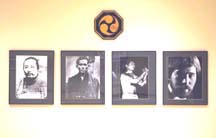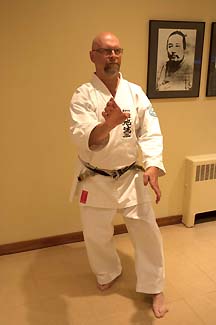Three Conflicts: Three treasures


Probably most, if not all, of us have heard that Sanchin Kata translates as Three Conflicts. And we have certainly heard that “all is in Sanchin”, as though the key to unlocking the mysteries of Uechi-ryu is simply in practicing that very basic but all inclusive kata. Usually, at some point, we may wonder if that’s really true, if it’s possible to become a master through performing those rather simple repetitions of three steps and arm strikes forward, turn and repeat, turn back forward and repeat, and so forth. It’s a fairly generic and limited set of movements, and, while they form the basis for many of the movements that follow in the other Kata, they hardly seem sufficient on their own. So to what does “all is in Sanchin” refer ? I suggest that we remember the Three Conflicts.
What are the Three Conflicts? One of the original symbols of Uechi-ryu, the three interlocking tear drops, offers an elegant answer. Whatever the conflicts are, it is clear from the symbol that they form a whole. Taking that knowledge a step further, what appears to be conflicting can offer resolution in wholeness and through integration. One of the basic series of three conflicts is Form/Speed/Power. This is the domain of the physical, an important domain. However, an overemphasis on one of those aspects usually occurs to the detriment of the others.
So if I concentrate on correct form, even if based on core principles, I might not be capable of speed and power as I seek to perform each movement correctly. If I focus on speed, I might be sacrificing form and power. But if power is my goal, I might be using my body in such a way that I feel great strength and impact but the form and speed may not be accurate representations of the Uechi-ryu core principles. So let’s look at those core principles. For reasons of consistency we could reduce them basically to stance, proper body mechanics, posture and breathing. The purpose of those core principles is to create an equal potential for all students, regardless of body type.
While I recognize that some of us have created variances on those core principles, the question I always ask is, will a variance work for everyone? In all cases, where the answer has been yes, the core principles have not been changed or abandoned. Where the answer is no, it is clear that they have been transgressed. Probably the most captivating issue for most, if not all, Uechi-ryu karateka is that of power. Now, in the case of the three conflicts, power depends on speed and what is usually sacrificed is form. But to focus exclusively on power is to create an imbalance in the three conflicts rather than an integrated whole. When we are young that’s not so much of an issue, but, as we and our bodies age, the exclusive focus on power begins to wear on our bodies.
variance work for everyone? In all cases, where the answer has been yes, the core principles have not been changed or abandoned. Where the answer is no, it is clear that they have been transgressed. Probably the most captivating issue for most, if not all, Uechi-ryu karateka is that of power. Now, in the case of the three conflicts, power depends on speed and what is usually sacrificed is form. But to focus exclusively on power is to create an imbalance in the three conflicts rather than an integrated whole. When we are young that’s not so much of an issue, but, as we and our bodies age, the exclusive focus on power begins to wear on our bodies.
I always recommend, in the case of kata, practicing three times as much repetition at slow speed than at medium speed, and three times as much at medium speed than at fast speed. One of the not so surprising modern recognitions in the use of the body is that joints wear. Impacting the joints with the kind of power that many of us learn to generate has to be done wisely so that age does not become a limitation in a life-long practice of Uechi-ryu. The interesting thing is that one can learn to move slowly in such a way that impacting a training partner’s body with a slow punch will nevertheless move him or her effortlessly. The impact, since it is from a slow movement, will certainly not hurt the partner, but it’s interesting to see how his or her body is knocked backwards. This can only occur if there is an integration of movement. One’s ability to do this is only possible if the whole body is engaged in that slow punch, arising out of the core principles.
Here’s another important consideration with regard to Uechi-ryu core principles that is likely foreign to our North American way of thinking. We are all part of a Ryu. Now, while there may be many variations on the interpretation of the form of Uechi-ryu, we, each one of us, is connected to an un-broken lineage from Cho Tzu Ho (and likely earlier– I can only assume that Pwan Gai Noon was not his innovation) onwards. Therefore, we have a responsibility to that Ryu. It’s not every man or woman for himself or herself –I believe that’s called “mixed martial arts”. So there is a clear framework within which each of us and our dojo operates. I don’t have an opinion on how far we can stretch within that framework and still maintain it, but I do believe that we have a responsibility to the integrity of Uechi-ryu. With that responsibility also comes the apparent conflict of both maintaining that integrity but also doing what we can to advance the understanding and practice of our Ryu.
 I know that I certainly hope that my students’ abilities far exceed my own and I work with them to insure that will be so. What I have discovered over the years is that, indeed, we do not have to transgress core principles. Rather, we have to investigate them in as much depth as possible in order to fully mine their potential. I suspect that it’s all too easy to take them for granted and seek elsewhere for understanding and development.
I know that I certainly hope that my students’ abilities far exceed my own and I work with them to insure that will be so. What I have discovered over the years is that, indeed, we do not have to transgress core principles. Rather, we have to investigate them in as much depth as possible in order to fully mine their potential. I suspect that it’s all too easy to take them for granted and seek elsewhere for understanding and development.
We are fortunate to have been trained in a North American environment where open-mindedness and eclecticism is not inhibited, but, in the end, while we may change our view of how to use those core principles, they are not wisely abandoned.
Returning to the three conflicts, as I age, I become more and more aware of how valuable the integration/resolution of those apparent conflicts is. So let’s look at some other versions of the three conflicts such as Crane, Tiger and Dragon. These three animals are certainly quite distinct from each other but what is offered in the integration of the three is a wealth of ways of moving within each movement. Perhaps, even more importantly, is that what is offered by that integration is a fluid way of being, an ease of moving from soft to hard. Lightness, heaviness, spiralling, explosiveness, stillness, coiling, resilience, flexibility––if our bodies can fluidly manifest those qualities we have a nearly unlimited vocabulary of application.
Too often we discover something that works and stay within that comfort zone as a way of guaranteeing reasonable success in our Uechi-ryu. So the question arises, are we capable of convincingly moving as a crane, a dragon or a tiger? Probably most of us relate to one or another of the three, but can we truly integrate all of them so that, in the moment, our bodies can change appropriately to any one of the three? This demands a willingness, as in the words of a great Taiji master, “To invest in loss”. In other words, can we leave our comfort zone and explore other ways of moving and being? The integration of the three animals offers that as a possibility.
Mind/Body/Spirit is yet another version of the three conflicts. Instead of the usual western cartesian split between mind and body, both become integrated through our practice. And only then can Spirit begin to manifest. Here I must make the distinction between spirited and Spirit. At a mature place in our practice the energies of Crane, Tiger and Dragon become available and manifest as martial forces in our karate and through the movements. We cannot seek to go beyond ourselves to attain and control these martial forces because the effort of that arises from the self. Nor are these martial forces at our disposal. But we can allow the “kata to perform the kata”, essentially getting out of the way of ourselves and the flow while still being completely engaged through awareness and intent.
I believe that this is what Master Tomoyose has always meant by ” Sanchin state of mind”. It is a state that gets cultivated through our practice. Through this dedicated practice over time, what we call states of mind can become stages that evolve. Take awareness for example. Awareness is not fixed but rather can continuously expand through our practice. Certainly each of us can remember our initial struggles in learning the movement vocabulary of Uechi-ryu, which appears so simple but defies the usual athleticism. Our awareness was, likely, rather dim at those beginning stages. But as we progressed, our awareness increased to include the whole body and then our training partners as well.
As teachers, even while engaged in our own practice we find that we are critically aware of our students and their needs as well. And so forth. I have always described the spiritual as simply being aware of that which is beneath (if I can locate it as such) the surface of things. It’s important to recognize that awareness deeply impacts on mind and body.
Finally, the last three conflicts which I’ll bring up at this time are Form/Function/Feeling. The integration of these three results in the abiding joy of a life-long practice. Form without function is meaningless. Form without feeling results in empty, joyless movements. Function can’t exist without a form– at least a form that we recognize as Uechi-ryu. I believe that function without feeling is simply self defence –useful but limited as a life-long practice. And feeling without the other two? Unlikely. For me and many of my students, the integration of Form/Function/Feeling is a joy. There is no other way to describe it. It certainly keeps me going in my late 60s.
So I suggest that each of us deeply commit to examining the core principles and their integration. Personally, my martial exploration took me outside of Uechi-ryu in order for me to fully appreciate what was there all along. I’m delighted to say that the depths of Uechi-ryu offer unlimited exploration and certainly a lifetime of joy. And none of the three conflicts were conflicting at all.


